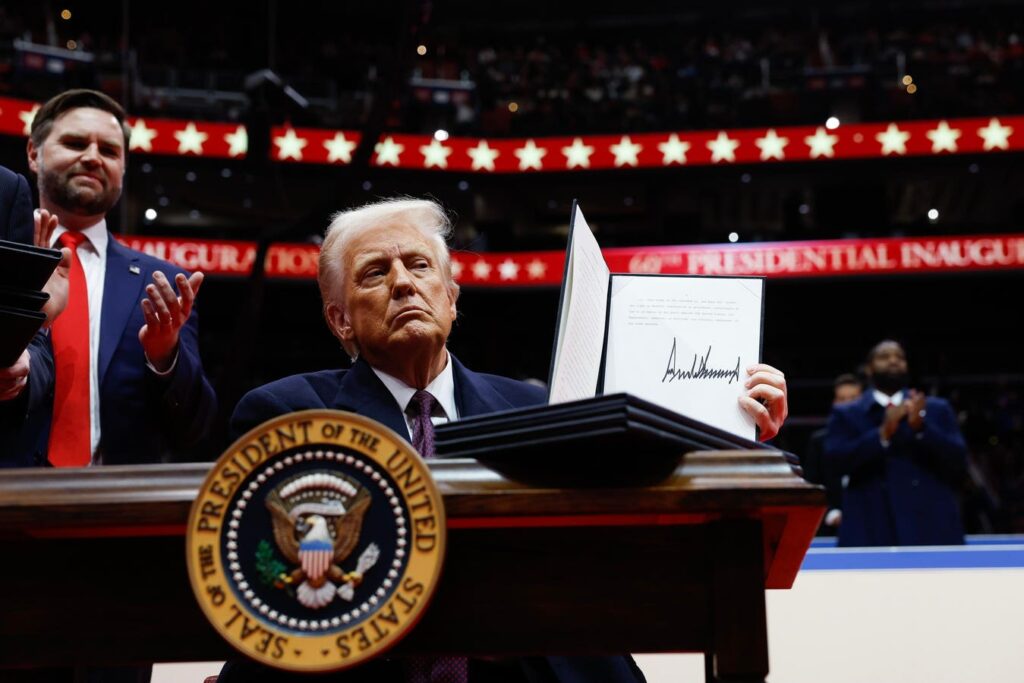Overview of Trump’s Executive Order on Federal Workforce
In his inaugural actions as President of the United States, Donald Trump has issued an executive order aimed at eliminating remote work for all federal employees. This significant decision is part of an overarching strategy to decrease the federal workforce through natural attrition.
WASHINGTON, DC – JANUARY 20: U.S. President Donald Trump holds up an executive order after signing it during an indoor inauguration parade at Capital One Arena on January 20, 2025. Trump officially takes office for his second term as the 47th president of the United States. (Photo by Anna Moneymaker/Getty Images)
Key Highlights of the Executive Order
President Trump has instructed all heads of departments and agencies within the executive branch to take immediate steps to end remote work provisions.
All federal employees will be mandated to return to their offices on a full-time basis.
The executive order stipulates that department heads should facilitate this transition “as soon as practicable.”
Leaders of the executive branch hold the authority to grant necessary exceptions to this rule.
Impact on Federal Employees
The executive order is poised to influence thousands of federal employees, many of whom have enjoyed flexible telework arrangements. According to the Office of Management and Budget, approximately 1.1 million federal civilian employees, representing 46% of the total workforce, were eligible for some form of telework. Of those, around 228,000 workers—about 10%—held fully remote positions.
Reactions from Key Figures
Elon Musk, who has been appointed to lead the newly formed Department of Government Efficiency, commented on this shift. He stated, “Requiring federal employees to come to the office five days a week would result in a wave of voluntary terminations that we welcome: If federal employees don’t want to show up, American taxpayers shouldn’t pay them for the Covid-era privilege of staying home.” This perspective highlights the administration’s intent to foster accountability among federal workers.
Background Context
The intention behind changing remote work policies aligns with Trump’s long-term goal of shrinking the federal workforce. Observers indicate that the administration may roll out additional measures to reduce regulations, cut government positions, and reorganize federal agencies. This restructuring could entail significant shifts, including relocating entire offices and transferring senior officials.
What to Anticipate Moving Forward
As part of these changes, Trump has mentioned plans to relocate up to 100,000 government jobs out of Washington, a tactic he previously used during his first term. His administration successfully moved the Bureau of Land Management’s headquarters to Colorado, resulting in the departure of 287 employees.
Conclusion and Future Implications
In the waning days of his first term, Trump established Schedule F, a category meant to reclassify certain federal employees, which would strip them of job protections. This new classification aimed to facilitate the termination and replacement of civil servants with individuals more aligned with Trump’s administration. The long-term implications of this executive order may reshape the landscape of federal employment and governance.
Federal Work Policies Shift Under New Leadership
In a bold move that signifies a new direction for federal employment, the current administration has enacted a directive that ends remote work for federal employees. This decision aims to streamline operations and is expected to significantly reshape the federal workforce landscape.
On January 20, 2025, President Donald Trump signed pivotal executive orders during his inauguration. This marks the beginning of his second term as the 47th President of the United States. (Photo by Anna Moneymaker/Getty Images)
Key Directives and Implications
Department heads across the executive branch have been instructed to end remote work arrangements, marking a significant policy shift.
All federal employees will now be required to return to the office full-time, a requirement that reflects a growing emphasis on in-person operations.
The decision mandates a swift transition to this new policy, stressing the need for departments to act “as soon as practicable.”
While this directive is clear, department leaders have the leeway to grant exceptions as necessary.
Expert Opinions on the New Policy
Elon Musk, now leading an initiative aimed at enhancing governmental efficiency, supports the return to in-person work. He argues that it could lead to natural attrition among federal employees who prefer remote arrangements, suggesting that taxpayer money should not be spent on positions that may be underperforming under flexible work conditions.
State of the Federal Workforce
Data indicates that nearly 1.1 million federal civilian employees, comprising 46% of the total workforce, were eligible for telework. Out of this group, about 10% held fully remote positions. The new directive is poised to impact a substantial portion of this workforce, signaling a return to traditional work environments.
Strategic Movements in Government Structure
The administration intends to implement various strategies aimed at reducing federal positions, streamlining processes, and reorganizing agencies. Such measures may include relocating offices and transferring senior officials, echoing past strategies from previous administrations.
Looking Ahead
Plans are underway to potentially relocate up to 100,000 government jobs outside of Washington, D.C., reminiscent of prior efforts aimed at decentralizing federal operations. Evidence of this approach can be seen with the relocation of the Bureau of Land Management’s headquarters, which resulted in the departure of numerous employees.
Continuing Developments
As the administration pushes for these changes, observers are keenly watching how the landscape of federal employment will transform. The implications of these directives will unfold in the coming months, as the government navigates the complexities of workforce management in a post-COVID era.
Conclusion
This transition marks a significant moment for federal policies centered around work arrangements. With the emphasis on in-person attendance, the new directives have the potential to redefine employee engagement and productivity within the federal government.


